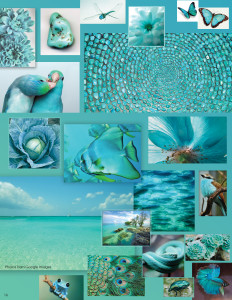The color turquoise is commonly associated with tranquility, wisdom, protection, creativity, emotional balance, good luck, friendship, joy, patience, intuition, and loyalty.

POSITIVE ASPECTS:
Peacefulness, Serenity, Wholeness, Creative Expression, Empathy, Optimism, Renewal, Innovation, Intuition, Humanity, Joy, Patience, Protection, Wisdom
CHALLENGES:
Pessimism, Lack of creative expression
CHAKRA: Throat & Heart
MINERALS:
Turquoise, Aquamarine, Amazonite, Chrysocolla, Boulder Opal, Gem Silica, Apatite, Smithsonite, Hemimorphite
Did you know?
The word turquoise comes from the French pierre turquoise, which means “Turkish stone”, as the gem was originally imported from Turkey. In old times, these blue-green stones were widely sold and bought in Turkish bazaars. The Turks favored this color so much so that they decorated many of their buildings with turquoise glazed tiles.
Originally mined in central Asia, Turquoise reached Europe through trading routes that passed through Turkey and quickly became a popular gem for jewelry and ornamentation. Grave furnishings with turquoise inlay were discovered in ancient Egypt, dating from approximately 3000 BC. Native Americans also found deposits in rock layers in cliffs and believed this mineral had spiritual significance and ceremonial relevance.
COLOR HEALING / COLOR THERAPY
The color turquoise ranges from light aqua to radiant azure green and from vivid sky blue, called celeste,todeep shades of teal.
Turquoise combines the calming, expansive nature of green and the cool, quiet flow of blue. In Color Therapy, turquoise is often used for invoking courage and strength. It can also be applied in order to influence honest communications and to encourage communication with higher dimensional beings. Most commonly used modalities include Crystal Therapy, Visualization, Color Silk Therapy, and Colorpuncture.
ATTRIBUTES
Turquoise is believed to enhance intuition and sensitivity. It can help calm the nerves and bring a sense of confidence. It is also said that the color turquoise could motivate us “to experience life to the fullest”.
Turquoise is associated with the desire for freedom to be a unique individual. It allows the expression of our dreams and wishes. It brings together the green energies of growth and desires with the blue qualities of communication. Whatever the need may be in the heart, the blue ingredient in turquoise ensures that it will communicate itself and be recognized
Those with a preference for turquoise typically don’t want to feel restricted in any way. They are extremely adaptive and efficient. A person with an aversion to turquoise may be unable to communicate emotions and reluctant to think originally or to walk new paths.
WEARING TURQUOISE
Incorporate turquoise into your wardrobe when you feel depressed, have low energy and a lack of interest in life. Wearing turquoise may be beneficial when you feel that you don’t fit in with your surroundings or when you need courage to strike out on your own. You can wear turquoise jewelry to give yourself confidence and strength.
TURQUOISE IN THE HOME
Turquoise is believed to provide protection from any negativity and to attract prosperity. In the home, turquoise can establish a connection to the elements, especially water and air. This calming as well as uplifting color can bring peace and higher energy to any space. It can be applied as a wall color or accent color for children’s rooms, home offices, and family rooms. Use turquoise in moderation, as too much of this color can cause us to become overly analytical, fussy, and egocentric.
SOURCES:
www.bourncreative.com/meaning-of-the-color–turquoise
www.deeptrancenow.com/colortherapy.htm
www.energyandvibration.com/colorturquoise
www.fengshui.about.com
